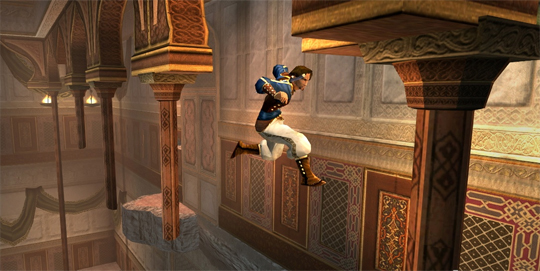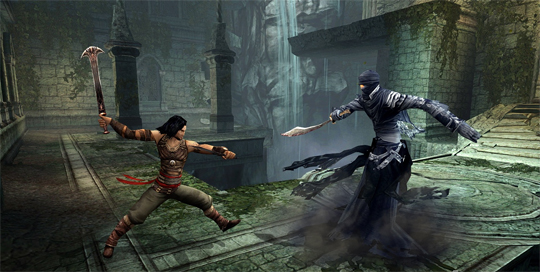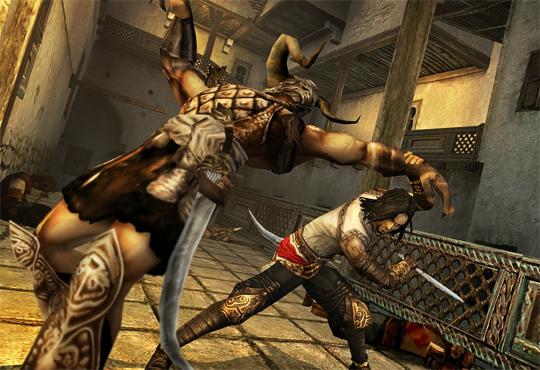Ubisoft did not pioneer the critically acclaimed Prince of Persia franchise, but some might say that it reached its peak with the company’s Sands of Time trilogy from the early 2000s. Now, after one departure and one revisitation to the series, Ubisoft has decided to follow the recent trend of high-definition, re-release compilations, bringing the full trilogy to the PS3 on a single blu-ray disc. While Prince of Persia Classic Trilogy HD‘s primary update is in the visual department, and that update is more of an HD “sharpening” than a comprehensive overhaul, the compilation survives and thrives on the strength of the games that comprise it. The Sands of Time, Warrior Within, and The Two Thrones have aged gracefully, and remain excellent examples of the acrobatic platforming subgenre they defined when initially released about a half-decade ago.

Prince of Persia: The Sands of Time re-introduced the Prince to gamers after a six-year hiatus and has enjoyed the most favorable critical reception of all the games in the collection. Much of this is thanks to the game’s excellent storytelling, which is at its best in this entry. The Sands of Time is presented as a literal retelling of events, narrated by the Prince himself, and recounts the story of how the sands were first released and later re-contained. Within the framework of the Prince’s adventure through the Palace of Azad, characters also entertain with fresh and continuous dialog that makes the tale all the more human and endearing.
The game still retains tight and responsive platforming action; players can easily direct the Prince to run along walls, shuffle down ledges, climb up and down giant columns, swing from horizontal bars, and generally defy gravity with daring leaps between every surface within the bounds of the palace walls. Successfully executing a sequence of acrobatic moves through any of the game’s well designed and clearly presented acrobatic puzzles is very satisfying, and always lends a feeling of empowerment and accomplishment to the player manipulating the controller.
On the other hand, just as when we played the game back in 2005, combat in this first game leaves something to be desired. It is still the primary gripe, as the many fight scenes feel like small but consistent derailments from what the game was meant to be, and would be better off remaining: a pure platformer. Combat is not at all integrated into the game’s platforming aspect; it is sectioned off into distinct segments, with clear beginning and end points, completely removed from the Prince’s acrobatic antics. These portions of play are also quite repetitive, and players will find themselves using the same few techniques on a handful of similar types of enemies repeatedly in order to finish fights quickly and successfully. Considering these sand warriors continue to respawn for what feel like eternities, this routine loses novelty very quickly. The many traps throughout the palace could have easily been the only foes in the game until the final confrontation with the game’s major antagonist.
Aside from this and a number of control disruptions related to changes in camera perspective, the game does make an excellent overall impression with its platforming and time-reversing mechanics, as well as with its highly enjoyable narrative.

When released to the masses in 2004, Prince of Persia: Warrior Within suffered, in a teen-angst sort of way, for being too different from its beloved predecessor. When experienced immediately following the first game, however, without the handicap of a long period of anticipation, this seven-year-old title can be better appreciated for the changes it makes.
Warrior Within takes place on the Island of Time, where the Prince toils to prevent the Sands from ever being created, thus erasing everything that had happened since he inadvertently released them in Azad, at the same time saving himself from the Final-Destination-esque enforcer of fate, the Dahaka. This game introduces a time-travel element, making players explore the temple grounds in both the present and the past. This also means that there is some backtracking involved, and players must retread the same areas multiple times. A fairly useless map doesn’t help players navigate the small handful of diverging paths the game presents, and some of the elegance of The Sands of Time was lost in this game thanks to the new direction in level design, despite new ways for the prince to navigate, like sliding down curtains or swinging on ropes. Still, when the player isn’t getting lost or turned around, Warrior Within’s pace proves to be rapid, and superior to its predecessor.
Warrior Within also features an improved combat system with dual wielding of temporary second weapons, more environmental interaction, and many more moves and combo opportunities. Combat is better integrated into play, as well, making progressing through a mixture of platforming and combat situations feel more natural and enjoyable, and enemies are far more diversified than before, better characterized by their notably differing appearances, fighting styles, voices, and levels of challenge. This game even includes a few large-scale, boss-type foes that require completely different approaches in order to be victorious. This variance serves to draw players into the Prince’s character and overall predicament.
One of the main knocks against Warrior Within at the time of its initial release was its fairly crummy soundtrack, which is admittedly not going to win any awards for best score. Taken along with the darker tone and look of this game, however, and especially when following the first game within minutes, rather than years, the contrast is far more welcome than I can remember it being when the game was originally released. It’s funny how an older game can still be a pleasant surprise.

Prince of Persia: The Two Thrones (or as I like to call it, Assassin’s Creed Zero; seriously, look at that costume) rounds out the trilogy, and yet again improves upon the series’ play mechanics with simultaneously complexified and streamlined combat, as well as numerous new ways to navigate town, temple, palace, and underground environments. While the game’s character-switching could leave players wishing for some Prince-only consistency, the addition of stealthy speed kills, the return of voice-over narration, and the swift pace of play combine to produce perhaps the most comprehensive PoP experience in the trilogy.
What truly sets The Two Thrones apart from the previous games is not the fact that players switch between two characters who operate differently from one another — though that distinction is undeniable — it is the speed kill mechanic that is introduced while players control the Prince in either one of his two forms. While an enemy’s back is turned, the tap of a button initiates a speed kill, after which players must tap the square button one to four times when the Prince’s dagger glows. Successful timing leads to an instant assassination, and missing a strike sends the Prince into standard combat.
As the Dark Prince, players must kill in order to regain health, which is otherwise steadily draining away. This version of the game’s protagonist wields a chain of blades that allows him to grapple and swing from special points scattered along his path forward. It also changes the way speed kills work; button taps are replaced by repeated mashing, and he saws his victims’ heads off from behind (or sometimes, above).
To be blunt, the game would have been better without the Dark Prince, but far more time is spent in his normal form, where the game shines. Speed kills, fast combat, expanded platforming, and persistence of narrative make this yet another great play experience, and an obvious precursor to Ubisoft Montreal’s next acrobatic assassin franchise, in some ways even besting elements of that later series.
It’s hard not to recommend Prince of Persia Classic Trilogy HD, especially to those who have yet to play all of the games, in which case it is nearly required playing. For Prince of Persia veterans and fans, revisiting the series is still a delight; all three games have aged quite well and benefit from small graphical upgrades as well as the incorporation of 3D TV support. Any way you slice it, three games of this caliber all bundled together on one disc are definitely worth the price of entry.

















